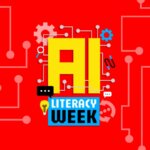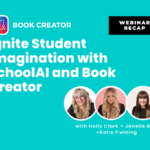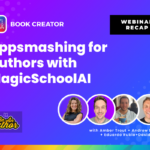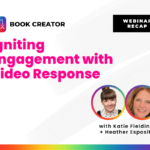AI Literacy Week is all about helping educators, students, and families build the skills they need to understand and use artificial intelligence responsibly. Across each session, expert guests shared practical tools, classroom-ready strategies, and inspiring examples of how AI can support—not replace—human creativity and judgment.
Grab all slides, templates, and examples in one place →
“AI literacy” = media literacy with modern tools
Guests: Nick Provenzano (SchoolAI) | Host: David Hotler (Book Creator)
Nick framed AI literacy as an extension of media literacy: understand what the tool is, where it helps, where it harms, and the responsibility that comes with its power. Ignoring AI doesn’t keep kids safe—it just pushes use into the shadows.
Teachers need space to explore without fear and systems that make the safe path the easy path.
Big idea: Schools should designate trusted “advance scouts” (coaches) to test tools, filter noise, and localize frameworks to the school’s culture. Clear norms + policies reduce “rogue tool” risk and the paralysis that comes from limited teacher time.
A safer route: the “walled garden” intermediary
David and Nick contrasted public chatbots with a school-ready intermediary.
- Public models can ingest identifying info—off limits for educators.
- SchoolAI positions itself as a COPPA/FERPA-compliant layer: encrypted end-to-end, vendor-blinded, and not using your data to train its models.
- Behind the scenes, SchoolAI routes a question to the best model (language, math, images, etc.), then returns results inside a protected environment.
Why that matters:
- Teachers can responsibly incorporate IEP details to adapt lessons—in seconds, not hours.
- Districts get peace of mind: safety, compliance, and policy alignment built in.
- Educators keep agency: the tool helps, but doesn’t overstep pedagogy.
Meet Dot: building student “spaces” that actually help
Nick introduced Dot, SchoolAI’s builder for teacher- and student-facing Spaces. David live-modeled how a Space can become an in-room expert for Book Creator—answering “how do I…?” questions so teachers can focus on feedback and facilitation.
The secret sauce: TXT knowledge bases
David prepared ultra-light TXT files that contain:
- Every Book Creator support article (organized with keywords and metadata)
- A template knowledge base with every page template, ID, category, and description
Upload those TXT files to your Space and Dot becomes a Book Creator pro—without writing for students or crossing classroom rules.
📥 Grab the TXT files on page 21 of the AI Literacy Resource Book
Time is finite. Community turns overwhelm into momentum
Both emphasized: don’t expect every teacher to become an early adopter. Instead, rely on:
- Coaches to compress learning (PD, lunch-and-learns, model lessons)
- Clear policies so teachers can act confidently
- Community sharing so no one starts from scratch
SchoolAI’s community offers free micro-courses, exemplars, and a Champions network for support.
👉 Join the SchoolAI Community via a link in the resource book:
Try it now (and help curate the best examples)
David’s challenge: build your own Space with the TXT files—don’t wait for someone else to “make your GPT.”
- Remix the AI Literacy Resource Book → jump to page 21 to grab the TXT files
- Create your own Space in SchoolAI and upload them
- Share your best creations in the SchoolAI Community or the Book Creator Facebook Group
📥 Start here: AI Literacy Resource Book »
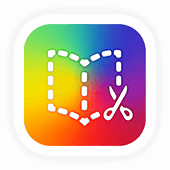
Get Book Creator for your school!
- Upgraded accounts for all your teachers
- Implementation plan to help with rollout
- PD support
- Analytics & admin dashboard
With 20 years of experience in education, Katie is passionate about creating inclusive and accessible classrooms for all students. She loves exploring new places, trying different foods, and connecting with fellow educators.



